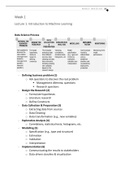MADS MADLAD |8
Week 1
Lecture 1: Introduction to Machine Learning
Data Science Process
- Defining business problem (1)
o Ask questions to discover the real problem
▪ Management dilemma, questions
▪ Research questions
- Design the Research (2)
o Formulate hypotheses
o Literature research
o Define Constructs
- Data Collection & Preparation (3)
o Extracting data from sources
o Data Cleaning
o Data transformation (e.g., new variables)
- Explorative Analysis (4)
o Correlations, statistical tests, histograms, etc.
- Modelling (5)
o Specification (e.g., type and structure)
o Estimation
o Validation
o Interpretation
- Implementation (6)
o Communicating the results to stakeholders
o Data-driven storyline & visualization
, MADS MADLAD |9
- Monitoring (7)
o Monitoring the model’s performance
Criteria for a good model
- Simple
- Evolutionary
o Starting simple but building it up
- Complete
o As complete and simple as possible
- Adaptive
- Robust
o Able to use it in different circumstances
(e.g. during inflation, COVID, etc.)
What is (Machine) Learning?
Machine learning is concerned with computer programs that automatically
improve their performance through experience.
- Branch of AI and CS, which focuses on use of data and algorithms to
imitate the way that humans learn.
, M A D S M A D L A D | 10
3 Types of ML Models
- Supervised: uses a training set, including both input and correct (e.g.
labeled) output, to teach models to yield the desired output.
o Input + Annotations -> Model -> Prediction
o Used for: classificaition (sorting items into categories), regressions
- Unsupervised: Identifies patterns in data sets containing data points
that are neither classified nor labeled.
- Reinforcement: enforces models (gives feedback or corrections) to learn
how to make predictions.
- Visual Examples of the 3 Types:
, M A D S M A D L A D | 11
ML Techniques





